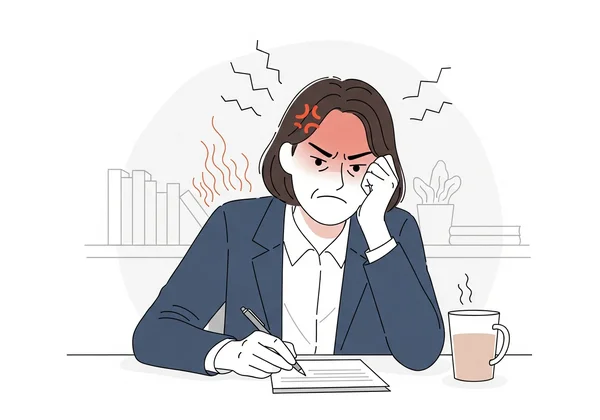Free Anger Test: Workplace Anger Management & Conflict Resolution
Are workplace frustrations boiling over into unproductive arguments or silent resentment? It's a common struggle in high-pressure environments, where deadlines, difficult colleagues, and heavy workloads can create a perfect storm for emotional distress. Discover professional strategies to manage anger, de-escalate conflicts, and channel intense emotions into productive outcomes for a healthier, more collaborative work environment. How to know if I have anger problems at work is a critical first question on the path to self-improvement.
Understanding your emotional responses is the first step toward gaining control. By learning to navigate these challenges constructively, you not only improve your own well-being but also contribute to a more positive and efficient workplace culture. A great starting point is a confidential anger assessment test to gain objective insights into your patterns.

Understanding Your Anger Triggers at Work
The first principle of effective anger management is self-awareness. Anger rarely appears out of nowhere; it's almost always a reaction to a specific trigger. Identifying what sets you off is crucial for developing proactive, rather than reactive, strategies. At work, these triggers can be subtle or overt, but they often tie back to feelings of being undervalued, disrespected, or powerless.
By pinpointing your personal triggers, you can anticipate challenging situations and prepare your response. This shift from unconscious reaction to conscious action empowers you to handle stress with professionalism and poise. Keeping a simple journal for a week to note when you feel frustrated can reveal surprising patterns and provide the clarity needed to make a change.
Common Sources of Workplace Frustration
Workplace anger often stems from a few key areas. Unrealistic deadlines or an overwhelming workload can create a sense of constant pressure and anxiety, making you more susceptible to frustration. Interpersonal conflicts, such as dealing with a difficult colleague or feeling unsupported by a manager, are also significant sources of stress.
Other common triggers include a lack of control over your work, feeling that your contributions are unrecognized, or perceiving unfairness in assignments or promotions. Even physical factors like a noisy, uncomfortable office environment can slowly erode your patience. Recognizing these sources is the first step toward addressing them directly or learning to mitigate their impact on your emotional state.
Recognizing the Signs of Rising Anger
Before an outburst, your body sends warning signals. Learning to recognize these signs gives you a crucial window of opportunity to de-escalate. Physically, you might notice a racing heart, tightened muscles in your jaw or shoulders, shallow breathing, or feeling hot. These are manifestations of your body's fight-or-flight response.
Emotionally, the signs can include irritability, sarcasm, a defensive tone, or a sudden urge to withdraw from a conversation. You might find yourself mentally replaying a negative interaction or catastrophizing a minor issue. Paying attention to these early cues allows you to step back, take a breath, and choose a more constructive response before the anger takes over.

Mastering Self-Management in High-Stress Situations
Once you can identify your triggers and recognize the warning signs, the next step is to develop techniques for managing your emotional state in real-time. Mastering self-management isn't about suppressing anger—it's about responding to it intelligently. This involves both immediate actions to calm yourself in a heated moment and long-term strategies to build your overall resilience to stress.
Effective self-management turns anger from a destructive force into a source of information. It signals that a boundary has been crossed or a need is not being met. By controlling your initial reaction, you give yourself the mental space to analyze the situation and address the root cause professionally. For deeper insights, you can always start your self-discovery journey online.
Immediate De-escalation Techniques for the Moment
When you feel anger rising, you need a quick, discreet plan of action. The simplest and most effective technique is focused breathing. Inhale slowly for four counts, hold for four, and exhale for six. This activates the parasympathetic nervous system, which has a calming effect on your body.
If possible, physically remove yourself from the situation for a few minutes. A short walk, even just to the water cooler, can break the emotional intensity. Another powerful technique is sensory grounding: silently name five things you can see, four things you can feel, three things you can hear, two you can smell, and one you can taste. This pulls your focus away from the emotional spiral and back into the present moment.

Cultivating Long-Term Emotional Resilience
Building lasting emotional control is an an ongoing practice, not a one-time fix. Regular exercise is one of the most effective ways to manage stress hormones and improve your mood. Similarly, prioritizing adequate sleep and a balanced diet provides the foundational strength your brain needs to regulate emotions effectively.
Mindfulness and meditation are also powerful tools for cultivating resilience. Even 10 minutes a day can train your brain to observe your thoughts without getting swept away by them. Finally, ensure you have healthy outlets for stress outside of work, whether it's a hobby, spending time in nature, or talking with trusted friends. Building a fulfilling life outside the office makes workplace frustrations less likely to dominate your emotional landscape. Ready to understand your anger?
Professional Strategies for Dealing with Angry Bosses & Colleagues
Navigating a professional environment requires managing not only your own emotions but also the emotions of others. When a boss or colleague is expressing anger, the situation can quickly become tense and unproductive. Your goal is to de-escalate the conflict, protect your own emotional well-being, and steer the conversation toward a constructive resolution.
Approaching these interactions with a clear strategy is essential. Reacting with defensiveness or aggression will only fuel the fire. Instead, adopting a calm, assertive, and empathetic stance can defuse the tension and open the door for genuine problem-solving. It’s a skill that demonstrates high emotional intelligence and leadership potential.
Communicating Effectively During Conflict
During a heated exchange, active listening is your most powerful tool. Allow the other person to speak without interruption, focusing on understanding their perspective, even if you don't agree with it. Use phrases like, "I hear that you're frustrated about X," to validate their feelings without necessarily accepting their claims.
When it's your turn to speak, use "I" statements to express your point of view without assigning blame. For example, instead of saying, "You're always dropping work on me at the last minute," try, "I feel overwhelmed when I receive urgent tasks late in the day because it impacts my ability to deliver quality work." This approach focuses on the problem, not the person, and keeps the dialogue collaborative.

Setting Healthy Boundaries and Expectations
Protecting yourself from chronic workplace anger often requires setting firm, professional boundaries. If a colleague frequently vents to you, it's okay to say, "I can see you're upset, but I need to focus on my work right now. Perhaps we can talk later?" This respectfully protects your time and emotional energy.
With a manager, this can be more challenging but is equally important. It involves clarifying expectations around communication and workload. If you're consistently receiving aggressive emails, you might address it by saying, "I'm fully committed to this project, and I find I work most effectively when feedback is delivered constructively. Can we schedule a brief check-in to discuss this?" Setting these boundaries is key to maintaining a sustainable and healthy professional life. If you feel this is a recurring issue, a multidimensional anger test can offer clarity.
When to Consider a Deeper Anger Assessment
While occasional frustration at work is normal, chronic anger or frequent, intense outbursts can be a sign of a deeper underlying issue. If you find that the techniques above aren't enough, or if your reactions at work are starting to feel out of your control, it may be time for a more structured self-assessment.
Understanding whether your workplace anger is situational or part of a broader pattern is a crucial step toward finding a lasting solution. An objective assessment can provide valuable insights into the frequency, intensity, and triggers of your anger, helping you see the bigger picture beyond just the office environment. This is where a scientifically-backed online anger test can serve as a valuable, private first step.
Recognizing Chronic Workplace Anger as a Broader Issue
Ask yourself: is your anger confined to work, or does it spill over into your personal life? Do you find yourself irritable with family and friends after a tough day? Do minor inconveniences outside of work trigger a disproportionately strong reaction? If so, your job may be exacerbating an anger pattern rather than being its sole cause.
Chronic anger can be a symptom of unresolved stress, burnout, or other underlying emotional challenges. Recognizing it as a broader issue is not a sign of failure but an act of profound self-awareness. It opens the door to seeking more comprehensive support and developing strategies that improve all areas of your life, not just your career. Taking a free anger test can be an empowering move toward understanding these patterns.

Take Control: Your Path to a Calmer Professional Life
Managing anger in the workplace is an essential skill for career success and personal well-being. By understanding your triggers, mastering de-escalation techniques, and communicating with professional poise, you can transform conflict into an opportunity for growth. Remember, the goal isn't to eliminate anger but to harness its energy constructively.
Your journey to a calmer professional life begins with a single, courageous step: self-assessment. If you're ready to gain a deeper understanding of your emotional patterns and unlock personalized insights, take the next step. To gain personalized insights, try our confidential and scientifically-backed anger test today. It’s the first move towards building a more resilient and empowered you.
The Takeaway
What are the main signs of anger issues in the workplace?
Key signs include frequent irritability, disproportionate reactions to minor setbacks, passive-aggressive behavior like gossiping or stonewalling, difficulty accepting feedback, and engaging in heated arguments with colleagues or supervisors. Consistently feeling defensive or cynical about your job can also be an indicator.
How can I know if my anger at work is a serious problem?
Your anger may be a serious problem if it's negatively impacting your professional relationships, affecting your job performance, or causing you significant personal distress. If you've received feedback about your temper, find yourself dreading work because of potential conflicts, or carry your anger home with you, it's a clear signal to take a closer look at your emotional patterns with a tool like an anger problems test.
What's the best way to control my anger during a work conflict?
The best immediate strategy is to pause before reacting. Take a deep breath to calm your physiological response. If the conversation is too heated, politely request a short break to collect your thoughts. Focus on listening to understand the other person's perspective and use neutral, problem-solving language instead of blaming.
Can a free online anger test help with workplace frustrations?
Absolutely. A well-designed, free online anger test can provide an objective and private way to assess your anger patterns. It can help you identify the intensity, frequency, and triggers of your anger, offering crucial insights that you might not see on your own. This self-awareness is the foundational step for addressing workplace frustrations effectively. You can discover your results and begin your journey toward better emotional management.